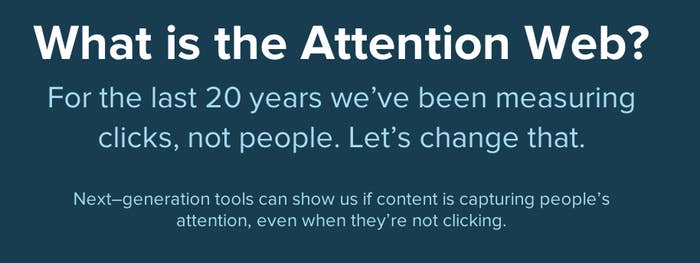
Every few months media types seem to loop back to a familiar question: How to measure media beyond the page view.
This week the Financial Times announced it would begin exclusively selling display ads off of a new metric: time spent. Medium recently reported it has started paying certain writers based on total time readers spend on articles. Upworthy made waves back in February ditching page views altogether to focus on what they call "attention minutes." And back in May the traffic analytics company Chartbeat launched its "Attention Web" campaign, in an attempt to move beyond the click.
"The thing about time spent is that it plays into three of the biggest trends right now — mobile, viewable impressions, and video," Eric Franchi, co-founder of the digital ad firm Undertone told BuzzFeed. Franchi, like many others in the ad tech world, have been working to champion viewability, an ad metric that makes sure readers actually see and engage with the ads on the page.
But behind all the attention is a concern among publishers that a new metric isn't ready to take the place of the reviled page views system. Historically, they're on to something; few things are as resilient on the internet as the page view. The industry standard metric has been declared dead for years, only to rise again as a reluctant publisher's best option. There is even some worry that if everyone embraces it too soon, there could be serious consequences for publishers, advertisers, and most importantly, readers.
At Gawker, editorial director Joel Johnson said there were no current plans to focus on time spent, arguing that reader satisfaction is a more important metric. "Perhaps someday, but that's cart before horse, really; what we want to measure is user engagement through satisfaction. Maybe time-on-page will be part of that, maybe not," he wrote in an email.
Other big publishers are equally ambivalent. Amy Phillips, an ESPN spokesperson for Nate Silver's Five Thirty Eight, said time spent, while monitored, was not the site's main focus. Similarly, Chris Thorman, who handles audience development at Vox Media, said time spent is not "a silver bullet metric" and only part of their larger analysis.
"Over at SB Nation, we don't really care if someone spends five minutes on a TV schedule, game-time post because that isn't the point," he said. "Different types of content serve different purposes, so time on site as an end-all, be-all metric doesn't really work at the moment."
Noah Chestnut, the director of The New Republic labs, echoed that sentiment and said that one of the biggest pitfalls of time spent is that all content isn't meant to be read for a long time. "We publish four to five longforms. If someone is spending 20 seconds there and leaving, it's not good," he said. "If you're reading a breaking item about Eric Cantor losing his race, 20 seconds on the page is probably OK."

Tony Haile, the CEO of Chartbeat, and arguably the industry's biggest champion of attention metrics, notes that, when it comes to time spent, most people are thinking about it the wrong way.
"The one interesting thing to bear in mind that gets lost is that you're looking at the total amount of attention over a month," Haile said. "If you give them a three-minute video and they watch it and don't come back, your total engaged time is three minutes. But if you give them a short article and they love it and come back, it is far, far greater. It doesn't have to be in one big lump. You can do it by writing one great piece or a whole bunch of great pieces that bring people back to your site."
Haile says that widespread adoption of Chartbeat's metrics it will create a better web, where sites with super-engaged audiences can charge more for ads and readers will end up with more content they want to spend time reading — but publishers, many of them simply trying to adapt to the web, are reluctant to move beyond the page view, not to mention the hellish logistical challenge of universal adoption.
Adopting a new media metric dredges up a host of concerns: What does an attention-obsessed media look like? What kind of content does it produce? What does it mean to readers? If previous metrics are any guide, unscrupulous publishers will be quick to game the system as they did with SEO. In a time-spent world, attention optimization is a very real worry.
"If time spent becomes important to advertisers — or to a publishing company's goals as a business — writers and editors will be pressured to try to get readers to spend more time on the page, in ways that are exciting and valuable to readers and ways that are cheap and frustrating," Gawker Editor-in-Chief Max Read told BuzzFeed.
Haile is betting that time spent will be much harder to exploit than cutting articles into a 30-part slideshow. "It's hard to game attention," Haile said. "This is moving from units to an actual currency, it's much much harder."
But Chestnut revealed what is perhaps the biggest fear of all journalists and publishers — that audiences just don't really care.
"We think we're really important and everything is worth time because we spend so much time doing it, but that's not the case," he said. "It forces us to be more honest about what we do. You really don't know from the data side if it's worth it yet. If people are willing to spend their time on something you do, there's value in it."
